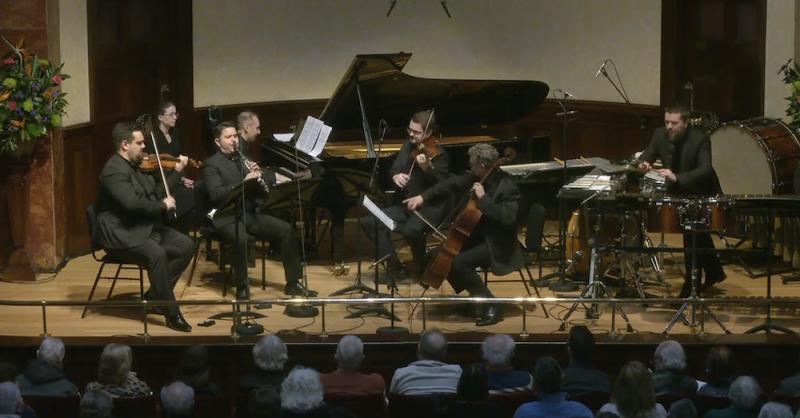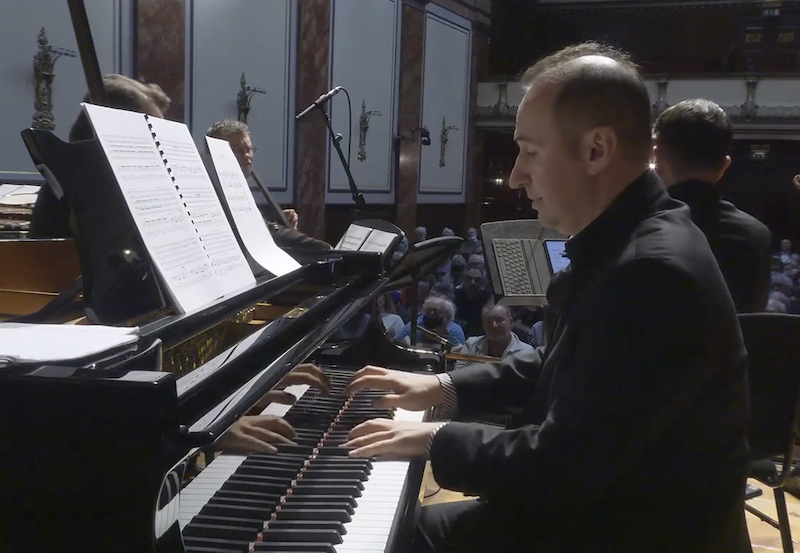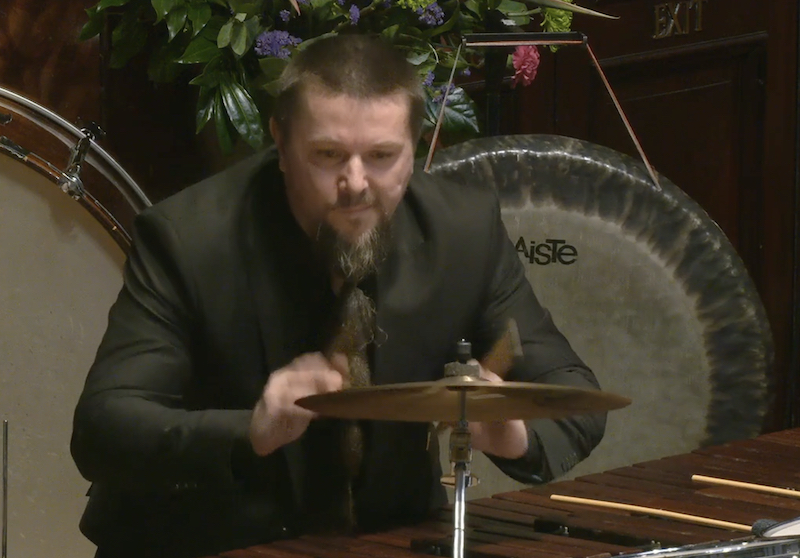Simon Trpčeski and Friends, Wigmore Hall online review – chamber music classics old and new | reviews, news & interviews
Simon Trpčeski and Friends, Wigmore Hall online review – chamber music classics old and new
Simon Trpčeski and Friends, Wigmore Hall online review – chamber music classics old and new
Quicksilver Connesson follows meaty Brahms and a Macedonian collaboration

The main course of this Wigmore lunchtime concert was Brahms but I was lured in by the dessert: a rare chance in this country to hear the music of the French composer Guillaume Connesson.
Sadly I was unable to be there in person, but caught the stream on the Wigmore’s website – their streaming of concerts that began during Covid seems to have become a permanent thing – and the concert is also available on BBC Sounds: I would strongly recommend having a look.
Brahms’s meaty third Piano Quartet was inspired by Goethe’s The Sorrows of Young Werther and also perhaps by the young composer’s complex relationship with Robert and Clara Schumann. Its rhetoric is forceful, not least in the scherzo, with Trpčeski as muscular here as he was gentle in the slow movement – and then thunderous in the double octaves of the finale. Violist Sorin Spasinovici was authoritative in his moments in the spotlight, and cellist Alexander Somov sang out his slow movement theme exquisitely. The group worked as a real collective, without any sense of Trpčeski (pictured above) – undoubtedly the ‘big name’ – being the frontman. Their playing was characterful and big-hearted, the music familiar, paving the way for some novelty.
The group worked as a real collective, without any sense of Trpčeski (pictured above) – undoubtedly the ‘big name’ – being the frontman. Their playing was characterful and big-hearted, the music familiar, paving the way for some novelty.
Pande Shahov – not a name I knew – is a Macedonian-born London resident who has made extensive arrangements of his native folk music for this group of players, for whom he also wrote his Quintet. This saw the viola replaced with clarinet and percussion (mainly vibraphone) and the clarinet writing owed something to Messiaen’s Quartet for the End of Time, especially in the slow second movement, beautifully played by Hidan Mamudov. But for much of the piece the vibraphone felt like an outsider to the rest of the group, both musically and timbrally. It came together better in the buzzing, scurrying finale, which raced to a helter-skelter end, Vlatko Nushev’s vibes mallets flying.
I have long been a committed admirer and advocate of Guillaume Connesson (b. 1970), who is widely performed in Europe and the US but almost completely overlooked in the UK. The Divertimento is an excellent introduction to his music – although as the original version was written in 1998 a lot of ink has flowed through his pen since then. It shows his skill in instrumental scoring, his melodic sensibility and his ability to entertain. The Divertimento is an arrangement by percussionist Vlatko Nushev (pictured above) of Connesson’s Sextet, faithful to the original for the most part but adding a busy percussion part, both tuned and untuned, that feels totally in keeping with Connesson’s original conception.
The Divertimento is an arrangement by percussionist Vlatko Nushev (pictured above) of Connesson’s Sextet, faithful to the original for the most part but adding a busy percussion part, both tuned and untuned, that feels totally in keeping with Connesson’s original conception.
The first movement owes a lot (and avowedly so) to John Adams. The percussion takes on much of the original oboe line, but now on marimba or xylophone, giving it a completely different colour. The martial snare drum adds a whole other element – not least in the big-top tattoo that counted in the finale (Nushev’s own addition). The Ravelian slow movement is the gorgeous heart of the piece, and here the percussion was all about deepening the nocturnal atmosphere, through quiet bass drum booms, swelling suspended cymbal and delicate glockenspiel underpinning Mamudov’s endlessly spun-out clarinet melody. (The occasional intonation insecurities in the clarinet were the only shortcomings of the whole performance.) The last movement shows Connesson as the heir to Poulenc: witty, quirky and joyous, with a brilliant punchline ending.
Trpčski was happy to sit back in the texture with his minimalist figuration and let the others lead the way – again Spasinovici was at the centre of things – but the hero, both as arranger and hyperactive performer, was Vlatko Nushev. His arrangement was as impressive as his belted beard, and if it can lead to wider recognition of Connesson’s wonderful music in this country, so much the better.
rating
Explore topics
Share this article
The future of Arts Journalism
You can stop theartsdesk.com closing!
We urgently need financing to survive. Our fundraising drive has thus far raised £49,000 but we need to reach £100,000 or we will be forced to close. Please contribute here: https://gofund.me/c3f6033d
And if you can forward this information to anyone who might assist, we’d be grateful.

Subscribe to theartsdesk.com
Thank you for continuing to read our work on theartsdesk.com. For unlimited access to every article in its entirety, including our archive of more than 15,000 pieces, we're asking for £5 per month or £40 per year. We feel it's a very good deal, and hope you do too.
To take a subscription now simply click here.
And if you're looking for that extra gift for a friend or family member, why not treat them to a theartsdesk.com gift subscription?
more Classical music
 Kanneh-Mason, Britten Sinfonia, Shave, Milton Court - a grin and a big beaming smile
A pair of striking contemporary pieces alongside two old favourites
Kanneh-Mason, Britten Sinfonia, Shave, Milton Court - a grin and a big beaming smile
A pair of striking contemporary pieces alongside two old favourites
 theartsdesk at the New Ross Piano Festival - Finghin Collins’ musical rainbow
From revelatory Bach played with astounding maturity by a 22 year old to four-hand jazz
theartsdesk at the New Ross Piano Festival - Finghin Collins’ musical rainbow
From revelatory Bach played with astounding maturity by a 22 year old to four-hand jazz
 First Person: Manchester Camerata's Head of Artistic Planning Clara Marshall Cawley on questioning the status quo
Five days of free events with all sorts of audiences around Manchester starts tomorrow
First Person: Manchester Camerata's Head of Artistic Planning Clara Marshall Cawley on questioning the status quo
Five days of free events with all sorts of audiences around Manchester starts tomorrow
 Goldscheider, Brother Tree Sound, Kings Place review - music of hope from a young composer
Unusual combination of horn, strings and electronics makes for some intriguing listening
Goldscheider, Brother Tree Sound, Kings Place review - music of hope from a young composer
Unusual combination of horn, strings and electronics makes for some intriguing listening
 theartsdesk Q&A: composer Donghoon Shin on his new concerto for pianist Seong-Jin Cho
Classical music makes its debut at London's K-Music Festival
theartsdesk Q&A: composer Donghoon Shin on his new concerto for pianist Seong-Jin Cho
Classical music makes its debut at London's K-Music Festival
 Helleur-Simcock, Hallé, Wong, Bridgewater Hall, Manchester review - moving lyricism in Elgar’s concerto
Season opener brings lyrical beauty, crisp confidence and a proper Romantic wallow
Helleur-Simcock, Hallé, Wong, Bridgewater Hall, Manchester review - moving lyricism in Elgar’s concerto
Season opener brings lyrical beauty, crisp confidence and a proper Romantic wallow
 Kohout, Spence, Braun, Manchester Camerata, Huth, RNCM, Manchester review - joy, insight, imagination and unanimity
Celebration of the past with stars of the future at the Royal Northern College
Kohout, Spence, Braun, Manchester Camerata, Huth, RNCM, Manchester review - joy, insight, imagination and unanimity
Celebration of the past with stars of the future at the Royal Northern College
 Jansen, LSO, Pappano, Barbican review - profound and bracing emotional workouts
Great soloist, conductor and orchestra take Britten and Shostakovich to the edge
Jansen, LSO, Pappano, Barbican review - profound and bracing emotional workouts
Great soloist, conductor and orchestra take Britten and Shostakovich to the edge
 Jakub Hrůša and Friends in Concert, Royal Opera review - fleshcreep in two uneven halves
Bartók kept short, and a sprawling Dvořák choral ballad done as well as it could be
Jakub Hrůša and Friends in Concert, Royal Opera review - fleshcreep in two uneven halves
Bartók kept short, and a sprawling Dvořák choral ballad done as well as it could be
 Hadelich, BBC Philharmonic, Storgårds, Bridgewater Hall, Manchester review - youth, fate and pain
Prokofiev in the hands of a fine violinist has surely never sounded better
Hadelich, BBC Philharmonic, Storgårds, Bridgewater Hall, Manchester review - youth, fate and pain
Prokofiev in the hands of a fine violinist has surely never sounded better
 Monteverdi Choir, ORR, Heras-Casado, St Martin-in-the-Fields review - flames of joy and sorrow
First-rate soloists, choir and orchestra unite in a blazing Mozart Requiem
Monteverdi Choir, ORR, Heras-Casado, St Martin-in-the-Fields review - flames of joy and sorrow
First-rate soloists, choir and orchestra unite in a blazing Mozart Requiem

Add comment